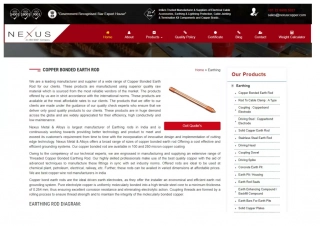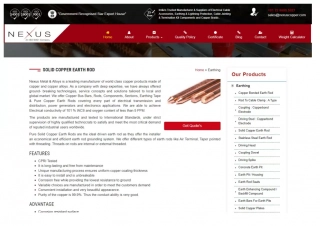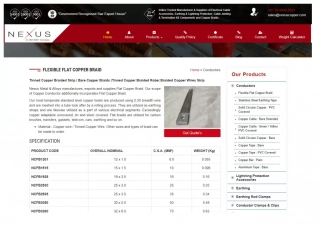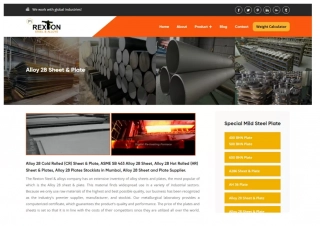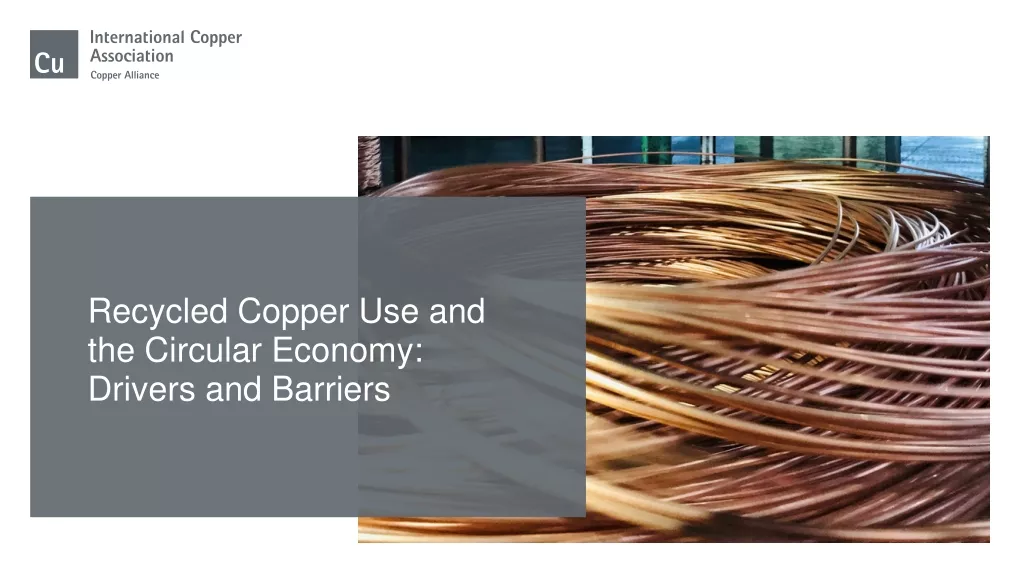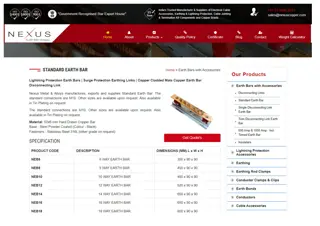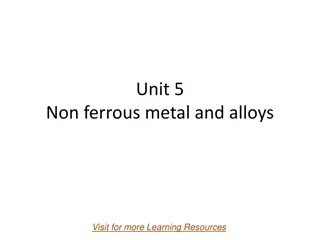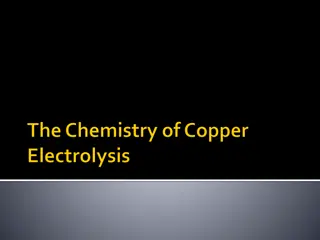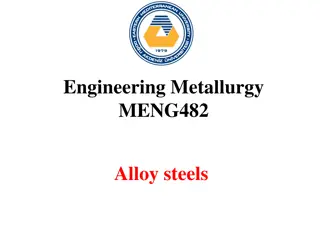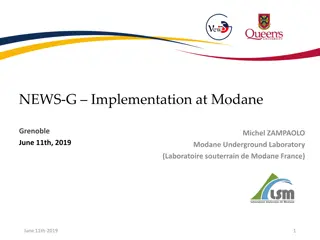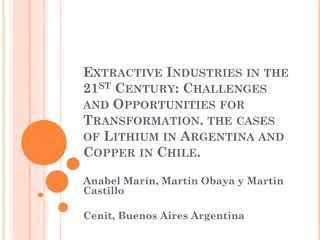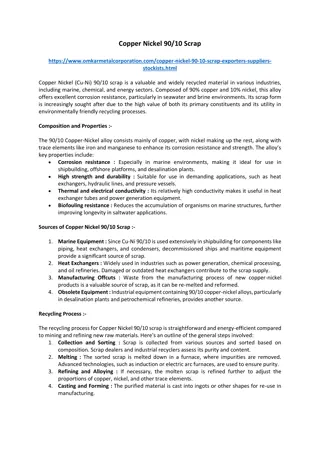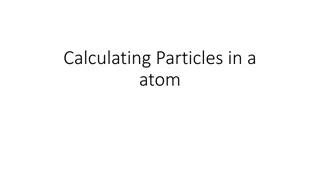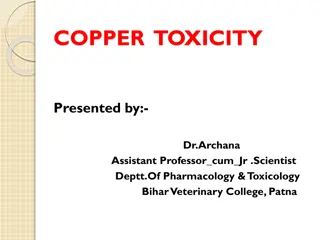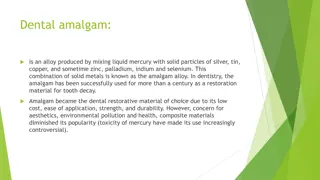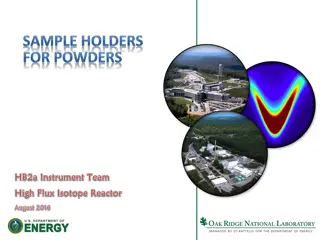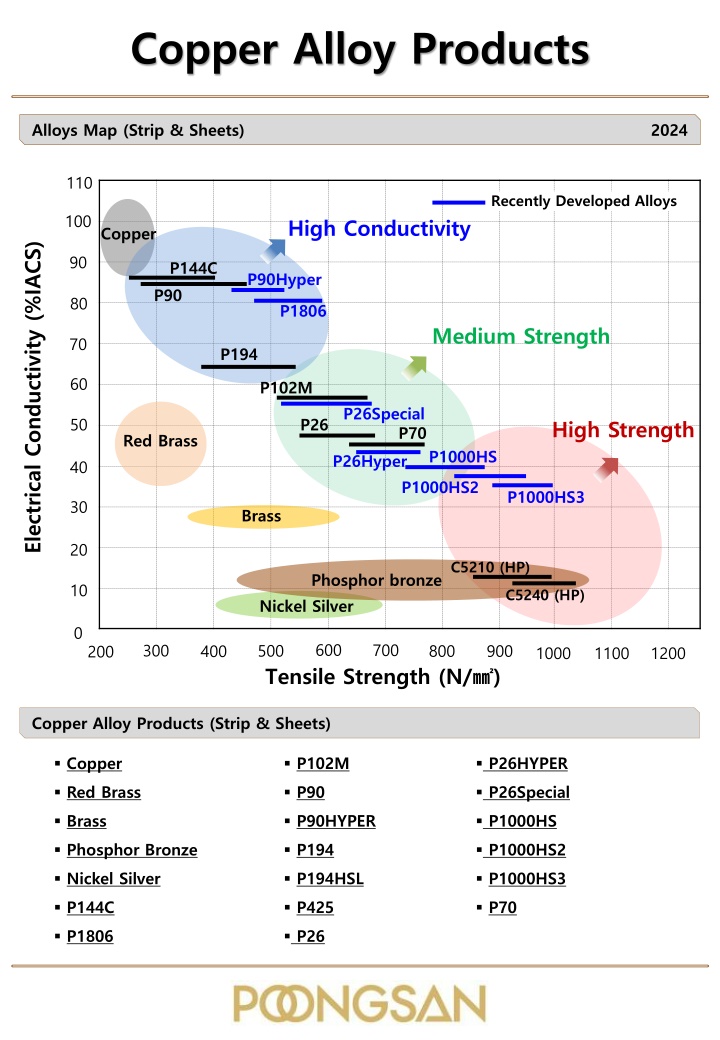
Copper Alloy Products
This content provides detailed information on copper alloy products, including recently developed high-conductivity alloys, tensile strength data, and strip & sheet products. It also covers the characteristics and applications of C1020 Oxygen-Free Copper, highlighting its bending properties, physical and mechanical features, and typical uses.
Download Presentation

Please find below an Image/Link to download the presentation.
The content on the website is provided AS IS for your information and personal use only. It may not be sold, licensed, or shared on other websites without obtaining consent from the author. If you encounter any issues during the download, it is possible that the publisher has removed the file from their server.
You are allowed to download the files provided on this website for personal or commercial use, subject to the condition that they are used lawfully. All files are the property of their respective owners.
The content on the website is provided AS IS for your information and personal use only. It may not be sold, licensed, or shared on other websites without obtaining consent from the author.
E N D
Presentation Transcript
Copper Alloy Products Alloys Map (Strip & Sheets) 2024 110 Recently Developed Alloys 100 High Conductivity Copper Electrical Conductivity (%IACS) 90 P144C P90Hyper P90 80 P1806 Medium Strength 70 P194 60 P102M P26Special 50 P26 High Strength P70 Red Brass P1000HS P26Hyper 40 P1000HS2 P1000HS3 30 Brass 20 C5210 (HP) Phosphor bronze 10 C5240 (HP) Nickel Silver 0 600 700 300 500 800 900 400 200 1000 1100 1200 Tensile Strength (N/ ) Copper Alloy Products (Strip & Sheets) Copper Red Brass Brass Phosphor Bronze Nickel Silver P144C P1806 P102M P90 P90HYPER P194 P194HSL P425 P26 P26HYPER P26Special P1000HS P1000HS2 P1000HS3 P70
Strip & Sheet Products Alloy UNS No. JIS No. Page Oxygen-Free Copper, OFC Tough Pitch Copper, TP Phosphorus Deoxidized (Low P), DLP Phosphorus Deoxidized (High P). DP Red Brass (RB1) Red Brass (RB2) Red Brass (RB3) Brass (B1) Brass (BA) Brass (B2) Brass (B3) Phosphor Bronze (PB1A) Phosphor Bronze (PB1B) Phosphor Bronze (PB2) Phosphor Bronze (PB3) Phosphor Bronze (Spring) Phosphor Bronze (Super Spring) Nickel Silver (NS1) Nickel Silver (NS2) Nickel Silver (NS3) Nickel Silver (Spring) P1240 Nickel Silver P144C P1806 P102M P90 P90HYPER P194 P194HSL P425 P26 P26HYPER P26Special P1000HS P1000HS2 P1000HS3 P70 C10200 C11000 C10300 C12200 C21000 C22000 C23000 C26000 C26800 C27200 C28000 C51100 C51000 C51900 C52100 C52100 C52400 C73500 C74500 C75200 C77000 - C14410 C18060 C19015 C19210 C19217 C19400 C19400 C42500 C64750 C64750 C19005 C64751 C64752 C64752 C70250 C1020 C1100 - C1220 C2100 C2200 C2300 C2600 C2680 C2720 C2801 C5111 C5102 C5191 C5212 C5210 C5240 - C7451 C7521 C7701 - C1441 - - C1921 - C1940 C1940 C4250 - - - - - - - 3 6 9 12 15 18 21 24 27 30 33 36 39 42 45 48 51 54 57 60 63 66 69 72 75 78 81 84 87 90 93 96 99 102 105 108 111 - 2 -
C1020 Oxygen-Free Copper UNS No. C10200 Features C1020 is a high purity, oxygen free, non phosphorus-deoxidized copper that does not contain in vacuum evaporating elements. High electrical and thermal conductivity. Good welding and excellent soldering properties. Excellent hot and cold forming properties. Typical Applications Automotive Rectifiers Tubes Heat sinks Coaxial Bus bars Conductors Cable Wire Sputtering target Chemical Composition Physical Properties (wt%) Cu 99.99 Melting Temperature 1083 O < 0.001 Specific Gravity 8.94 - Thermal Conductivity 391 W/(m K) 10-6/K Coefficient of Thermal Expansion 17.6 Modulus of Elasticity 117 GPa Poisson's Ratio 0.33 - Electrical Conductivity 101 %IACS Mechanical Properties Temper O 1/4H 1/2H H Tensile Strength MPa 195 215-285 235-315 275 Elongation % 35 25 15 - Hardness Hv - 55-100 75-120 80 0.2% Yield Strength MPa Max 140 180 250 320 - 3 -
C1020 Oxygen-Free Copper Bending Properties r/t (Minimum Bending Radius / thickness) Temper O 1/4H 1/2H H Good way 0.0 0.0 0.0 0.0 90O Bad way 0.0 0.0 0.0 0.5 Good way 0.0 0.0 0.5 1.0 180O Bad way 0.0 0.0 0.5 1.0 Bending Direction Strip thickness 0.5mm Test sample width 10mm A : Good Way (Transverse to RD) B : Bad Way (Parallel to RD) Softening Resistance Vickers hardness after heat treatment (30minute). The diagram shows typical values. 130 120 C1020-H 110 100 Hardness, Hv 90 80 70 60 50 40 30 20 10 0 0 100 200 300 400 500 600 700 Temperature( ) x 30min. - 4 -
C1020 Oxygen-Free Copper Stress Relaxation Resistance 100 Test Method Cantilever bending test equipment. Remaining Stress (%) = (h0-h1)/h0 100 C1020-H, 150oC 90 80 Remaining Stress [%] 70 60 50 40 30 20 Initial Stress : 80% of 0.2% Y.S Parallel Rolling Direction Initial Stress is 80% of Yield Strength 10 0 10 100 Time [h] 1000 Corrosion Resistance Resistant to : industrial atmosphere, industrial and water, pure water vapour, non oxidizing acids, alkalis, neutral saline solutions. Not resistant to : oxidizing acids, hydrous ammonia and halogenated gases, hydrogen sulfide, seawater, especially with flow rates. Fatigue Strength The highest stress that can be applied for a certain number of cycles without fracture is the fatigue strength. The standard fatigue strength for copper alloys is that reported for 100,000,000 cycles. It is about 1/3 of the tensile strength. Fabrication Properties Capacity for Being Cold Worked Excellent Oxyacetylene Welding Fail Capacity for Being Hot Formed Excellent Gas Shielded Arc Welding Good Soldering Excellent Coated Metal Arc Welding Not Recommended Brazing Excellent - 5 -
C1100 Tough Pitch Copper UNS No. C11000 Features C1100 is about 99.9% purity of copper. High electrical and thermal conductivity. Good drawability Corrosion resistance and weather resistance Typical Applications Automotive Radiators Automotive Gaskets Heat sinks Electrical Transformer Coils Bus bars Switches Heat Exchangers Terminals Terminal Connectors Chemical Composition Physical Properties (wt%) Cu 99.9 Melting Temperature 1083 Specific Gravity 8.91 - Thermal Conductivity 391 W/(m K) 10-6/K Coefficient of Thermal Expansion 17.6 Modulus of Elasticity 117 GPa Poisson's Ratio 0.33 - Electrical Conductivity 100 %IACS Mechanical Properties Temper O 1/4H 1/2H H Tensile Strength MPa 195 215-285 235-315 275 Elongation % 35 25 15 - Hardness Hv - 55-100 75-120 80 0.2% Yield Strength MPa - - - - - 6 -
C1100 Tough Pitch Copper Bending Properties r/t (Minimum Bending Radius / thickness) Temper O 1/4H 1/2H H Good way 0.0 0.0 0.0 1.0 90O Bad way 0.0 0.0 0.5 2.0 Good way 0.0 0.0 0.5 1.5 180O Bad way 0.0 0.0 1.0 2.5 Bending Direction Strip thickness 0.5mm Test sample width 10mm A : Good Way (Transverse to RD) B : Bad Way (Parallel to RD) Softening Resistance 130 Vickers hardness after heat treatment (30minute). The diagram shows typical values. 120 C1100-H 110 100 Hardness, Hv 90 80 70 60 50 40 30 20 10 0 0 100 200 300 400 500 600 700 Temperature( ) x 30min. - 7 -
C1100 Tough Pitch Copper Stress Relaxation Resistance 100 Test Method Cantilever bending test equipment. Remaining Stress (%) = (h0-h1)/h0 100 C1100-H, 150oC 90 80 Remaining Stress [%] 70 60 50 40 30 20 Initial Stress : 80% of 0.2% Y.S Parallel Rolling Direction Initial Stress is 80% of Yield Strength 10 0 10 100 Time [h] 1000 Corrosion Resistance Resistant to : industrial atmosphere, industrial and drinking water, pure water vapour, non oxidizing acids, alkalis, neutral saline solutions. Not resistant to : oxidizing acids, hydrous ammonia and halogenated gases, hydrogen sulfide, seawater, especially with high flow rates. Fatigue Strength The highest stress that can be applied for a certain number of cycles without fracture is the fatigue strength. The standard fatigue strength for copper alloys is that reported for 100,000,000 cycles. It is about 1/3 of the tensile strength. Fabrication Properties Capacity for Being Cold Worked Excellent Oxyacetylene Welding Not Recommended Capacity for Being Hot Formed Excellent Gas Shielded Arc Welding Fair Soldering Excellent Coated Metal Arc Welding Not Recommended Brazing Good - 8 -
C1030 Phosphorus Deoxidized (Low P) UNS No. C10300 Features C1030 is a high purity, low level residual phosphorus, deoxidized copper. High electrical and thermal conductivity. Good welding and soldering properties. Excellent hot and cold forming properties. Typical Applications High Frequency Cable Tubular Bus Commutators Tubular Bus Bus bars Switches Electrical Conductors Terminals Billet Mold Tube Chemical Composition Physical Properties (wt%) Cu 99.5 Melting Temperature 1083 P 0.001~0.005 Specific Gravity 8.94 - Thermal Conductivity 386 W/(m K) 10-6/K Coefficient of Thermal Expansion 17.6 Modulus of Elasticity 117 GPa Vickers hardness after heat treatment (30minute). The diagram shows typical values. Poisson's Ratio 0.33 - Electrical Conductivity 99 %IACS Mechanical Properties Temper O 1/2H Tensile Strength MPa 196 294-363 Elongation % 33 4 Hardness Hv 45~55 100-120 0.2% Yield Strength MPa - - - 9 -
C1030 Phosphorus Deoxidized (Low P) Bending Properties r/t (Minimum Bending Radius / thickness) Temper O 1/2H Good way 0.0 0.0 90O Bad way 0.0 0.0 Good way 0.0 0.5 180O Bad way 0.0 0.5 Bending Direction Strip thickness 0.5mm Test sample width 10mm A : Good Way (Transverse to RD) B : Bad Way (Parallel to RD) Softening Resistance 120 Vickers hardness after heat treatment (30minute). The diagram shows typical values. 110 C1030-1/2H 100 90 Hardness, Hv 80 70 60 50 40 30 20 10 0 0 100 200 300 400 500 600 700 Temperature( ) x 30min. - 10 -
C1030 Phosphorus Deoxidized (Low P) Stress Relaxation Resistance 100 Test Method Cantilever bending test equipment. Remaining Stress (%) = (h0-h1)/h0 100 90 C1030-1/2H, 150 80 Remaining Stress[%] 70 60 50 40 30 20 Initial Stress : 80% of 0.2% Y.S Parallel Rolling Direction Initial Stress is 80% of Yield Strength 10 0 10 100 1000 Time [h] Corrosion Resistance Resistant to : industrial atmosphere, industrial and drinking water, pure water vapour, non oxidizing acids, alkalis, neutral saline solutions. Not resistant to : oxidizing acids, hydrous ammonia and halogenated gases, hydrogen sulfide, seawater, especially with high flow rates. Fatigue Strength The highest stress that can be applied for a certain number of cycles without fracture is the fatigue strength. The standard fatigue strength for copper alloys is that reported for 100,000,000 cycles. It is about 1/3 of the tensile strength. Fabrication Properties Capacity for Being Cold Worked Excellent Oxyacetylene Welding Good Capacity for Being Hot Formed Excellent Gas Shielded Arc Welding Excellent Soldering Excellent Coated Metal Arc Welding Not Recommended Brazing Excellent - 11 -
C1220 Phosphorus Deoxidized (High P) UNS No. C12200 Features C1220 is a phosphorus-deoxidized copper with a limited, high amount of residual Phosphorus, high electrical and thermal conductivity. Excellent welding and soldering properties. Excellent hot and cold forming properties. Typical Applications Radiators Switches Casting Molds Gaskets Rotating Bands Marine Oil Coolers Connectors Heat Exchanger Shells Chemical Composition Physical Properties (wt%) Cu 99.9 Melting Temperature 1083 P 0.015~0.040 Specific Gravity 8.94 - Thermal Conductivity 339 W/(m K) 10-6/K Coefficient of Thermal Expansion 17.6 Modulus of Elasticity 117 GPa Poisson's Ratio 0.33 - Electrical Conductivity 85 %IACS Mechanical Properties Temper O 1/4H 1/2H H Tensile Strength MPa 195 215-285 235-315 275 Elongation % 35 25 15 - Hardness Hv - 55-100 75-120 80 0.2% Yield Strength MPa - - - - - 12 -
C1220 Phosphorus Deoxidized (High P) Bending Properties r/t (Minimum Bending Radius / thickness) Temper O 1/4H 1/2H H Good way 0.0 0.0 0.0 0.0 90O Bad way 0.0 0.0 0.0 0.0 Good way 0.0 0.0 0.5 1.0 180O Bad way 0.0 0.0 0.5 1.0 Bending Direction Strip thickness 0.5mm Test sample width 10mm A : Good Way (Transverse to RD) B : Bad Way (Parallel to RD) Softening Resistance 140 Vickers hardness after heat treatment (30minute). The diagram shows typical values. 130 C1220-H 120 110 Hardness, Hv 100 90 80 70 60 50 40 30 20 10 0 0 100 200 300 400 500 600 700 Temperature( ) x 30min. - 13 -
C1220 Phosphorus Deoxidized (High P) Stress Relaxation Resistance 100 Test Method Cantilever bending test equipment. Remaining Stress (%) = (h0-h1)/h0 100 C1200-H, 150oC 90 80 Remaining Stress [%] 70 60 50 40 30 20 Initial Stress : 80% of 0.2% Y.S Parallel Rolling Direction Initial Stress is 80% of Yield Strength 10 0 10 100 Time [h] 1000 Corrosion Resistance Resistant to : industrial atmosphere, industrial and drinking water, pure water vapour, non oxidizing acids, alkalis, neutral saline solutions. Not resistant to : oxidizing acids, hydrous ammonia and halogenated gases, hydrogen sulfide, seawater, especially with high flow rates. Fatigue Strength The highest stress that can be applied for a certain number of cycles without fracture is the fatigue strength. The standard fatigue strength for copper alloys is that reported for 100,000,000 cycles. It is about 1/3 of the tensile strength. Fabrication Properties Capacity for Being Cold Worked Excellent Oxyacetylene Welding Good Capacity for Being Hot Formed Excellent Gas Shielded Arc Welding Excellent Soldering Excellent Coated Metal Arc Welding Not Recommended Brazing Excellent - 14 -
C2100 Red Brass (RB1) UNS No. C21000 Features C2100 is low-cost alloy which is often selected to engineers for applications including coin, connectors, fuse caps. The combination of middle conductivity and improved strength make C2100 a valuable option for electrical applications. High corrosion resistance in atmosphere, fresh water and seawater Good plasticity Typical Applications Coin Connector Bullet Jackets Emblems Rotor Bars, Ac Motors Jewelry Fuse Caps Chemical Composition Physical Properties (wt%) Cu 94-96 Melting Temperature 1066 Zn Balance Specific Gravity 8.86 - Pb 0.05 Thermal Conductivity 234 W/(m K) 10-6/K Fe 0.05 Coefficient of Thermal Expansion 18.0 Modulus of Elasticity 117 GPa Poisson's Ratio 0.33 - Electrical Conductivity 56 %IACS Mechanical Properties Temper 1/4H 1/2H H Tensile Strength MPa 225-305 265-345 340 Elongation % 23 18 - Hardness Hv 45-75 75-110 110 0.2% Yield Strength MPa 130 200 280 - 15 -
C2100 Red Brass (RB1) Bending Properties r/t (Minimum Bending Radius / thickness) Temper 1/4H 1/2H H Good way 0.0 0.0 0.5 90O Bad way 0.0 0.0 1.0 Good way 0.0 0.0 1.5 180O Bad way 0.0 0.0 2.0 Bending Direction Strip thickness 0.5mm Test sample width 10mm A : Good Way (Transverse to RD) B : Bad Way (Parallel to RD) Softening Resistance 140 Vickers hardness after heat treatment (30minute). The diagram shows typical values. 130 C2100-H 120 110 Hardness, Hv 100 90 80 70 60 50 40 30 20 10 0 0 100 200 300 400 500 600 700 Temperature( ) x 30min. - 16 -
C2100 Red Brass (RB1) Stress Relaxation Resistance 100 Test Method Cantilever bending test equipment. Remaining Stress (%) = (h0-h1)/h0 100 C2100-H, 150oC 90 80 Remaining Stress [%] 70 60 50 40 30 20 Initial Stress : 80% of 0.2% Y.S Parallel Rolling Direction Initial Stress is 80% of Yield Strength 10 0 10 100 Time [h] 1000 Corrosion Resistance C2100 has good resistance to stress corrosion cracking and largely resistant to industrial atmosphere but not resistant to oxidizing acids. Fatigue Strength The highest stress that can be applied for a certain number of cycles without fracture is the fatigue strength. The standard fatigue strength for copper alloys is that reported for 100,000,000 cycles. It is about 1/3 of the tensile strength. Fabrication Properties Capacity for Being Cold Worked Excellent Oxyacetylene Welding Good Capacity for Being Hot Formed Good Gas Shielded Arc Welding Good Soldering Excellent Coated Metal Arc Welding Not recommended Brazing Excellent - 17 -
C2200 Red Brass (RB2) UNS No. C22000 Features C2200 alloy derives its name from its rich bronze color. It offers a unique properties that make it excellent for applications requiring resistance to corrosion. C2200 offers a unique set of properties that make it great for applications requiring resistance to corrosion. Unique color Good resistance to air, water Typical Applications Gaskets Ball Point Pens Compacts Bolts Rotor Bar AC Motors Cable Wrap Chain Links Costume Jewelry Chemical Composition Physical Properties (wt%) Cu 89-91 Melting Temperature 1043 Zn Balance Specific Gravity 8.8 - Pb 0.05 Thermal Conductivity 189 W/(m K) 10-6/K Fe 0.05 Coefficient of Thermal Expansion 18.4 Modulus of Elasticity 117 GPa Poisson's Ratio 0.33 - Electrical Conductivity 44 %IACS Mechanical Properties Temper 1/4H 1/2H H Tensile Strength MPa 255-335 285-365 350 Elongation % 25 20 - Hardness Hv 50-80 80-110 110 0.2% Yield Strength MPa 140 200 290 - 18 -
C2200 Red Brass (RB2) Bending Properties r/t (Minimum Bending Radius / thickness) Temper 1/4H 1/2H H Good way 0.0 0.0 0.5 90O Bad way 0.0 0.0 1.0 Good way 0.0 0.5 2.5 180O Bad way 0.0 0.5 2.0 Bending Direction Strip thickness 0.5mm Test sample width 10mm A : Good Way (Transverse to RD) B : Bad Way (Parallel to RD) Softening Resistance Vickers hardness after heat treatment (30minute). The diagram shows typical values. 160 150 C2200-H 140 130 120 Hardness, Hv 110 100 90 80 70 60 50 40 30 20 10 0 0 100 200 300 400 500 600 700 Temperature( ) x 30min. - 19 -
C2200 Red Brass (RB2) Stress Relaxation Resistance 100 Test Method Cantilever bending test equipment. Remaining Stress (%) = (h0-h1)/h0 100 oC C2200-H, 150 90 80 70 Remaining Stress [%] 60 50 40 30 20 Initial Stress is 80% of Yield Strength Initial Stress : 80% of 0.2% Y.S Parallel Rolling Direction 10 0 10 100 Time [h] 1000 Corrosion Resistance Good resistance to : fresh water, neutral or alkaline saline solutions, organic compounds Not resistant to : acids, hydrous sulphur compounds, Low sensitivity to stress corrosion cracking Fatigue Strength The highest stress that can be applied for a certain number of cycles without fracture is the fatigue strength. The standard fatigue strength for copper alloys is that reported for 100,000,000 cycles. It is about 1/3 of the tensile strength. Fabrication Properties Capacity for Being Cold Worked Excellent Oxyacetylene Welding Good Capacity for Being Hot Formed Good Gas Shielded Arc Welding Good Soldering Excellent Coated Metal Arc Welding Not Recommended Brazing Excellent - 20 -
C2300 Red Brass (RB3) UNS No. C23000 Features C2300 has highly resistant to stress corrosion cracking. It is commonly know is a choice for a wide range of applications. This material also has middle strength and is readily formed making it great for many industrial applications. Good corrosion resistance Good Formability Typical Applications Badges Fire Extinguisher Cases Pump lines Zippers Sockets Pipe Nipples Rotor Bars, AC motors Heat Exchangers Radiator Cores Chemical Composition Physical Properties (wt%) Cu 84-86 Melting Temperature 1027 Zn Balance Specific Gravity 8.75 - Pb 0.05 Thermal Conductivity 159 W/(m K) 10-6/K Fe 0.05 Coefficient of Thermal Expansion 18.7 Modulus of Elasticity 117 GPa Poisson's Ratio 0.33 - Electrical Conductivity 37 %IACS Mechanical Properties Temper 1/4H 1/2H H Tensile Strength MPa 275-355 305-380 355 Elongation % 28 23 - Hardness Hv 55-85 85-115 115 0.2% Yield Strength MPa 170 150 250 - 21 -
C2300 Red Brass (RB3) Bending Properties r/t (Minimum Bending Radius / thickness) Temper 1/4H 1/2H H Good way 0.0 0.0 1.0 90O Bad way 0.0 0.5 1.5 Good way 0.5 1.0 3.5 180O Bad way 0.5 2.0 5.0 Bending Direction Strip thickness 0.5mm Test sample width 10mm A : Good Way (Transverse to RD) B : Bad Way (Parallel to RD) Softening Resistance 180 Vickers hardness after heat treatment (30minute). The diagram shows typical values. 160 C2300-H 140 Hardness, Hv 120 100 80 60 40 20 0 0 100 200 300 400 500 600 700 Temperature( ) x 30min. - 22 -
C2300 Red Brass (RB3) Stress Relaxation Resistance 100 Test Method Cantilever bending test equipment. Remaining Stress (%) = (h0-h1)/h0 100 oC C2300-H, 150 90 80 70 Remaining Stress [%] 60 50 40 30 20 Initial Stress is 80% of Yield Strength Initial Stress : 80% of 0.2% Y.S Parallel Rolling Direction 10 0 10 100 Time [h] 1000 Corrosion Resistance Good resistance to : fresh water, neutral or alkaline saline solutions, organic compounds Not resistant to : acids, hydrous sulphur compounds Low sensitivity to stress corrosion cracking Fatigue Strength The highest stress that can be applied for a certain number of cycles without fracture is the fatigue strength. The standard fatigue strength for copper alloys is that reported for 100,000,000 cycles. It is about 1/3 of the tensile strength. Fabrication Properties Capacity for Being Cold Worked Excellent Oxyacetylene Welding Good Capacity for Being Hot Formed Good Gas Shielded Arc Welding Good Soldering Excellent Coated Metal Arc Welding Not Recommended Brazing Excellent - 23 -
C2600 Brass (B1) UNS No. C26000 Features C2600 cartridge have excellent workability. These alloys are usually cold formed and machined. Good formability Good hot forming Typical Applications Terminal connectors Ammunition cartridge cases Fasteners (Pins, Rivets) Radiator Chemical Composition Physical Properties (wt%) Cu 68.5-71.5 Melting Temperature 954 Zn Balance Specific Gravity 8.53 - Pb 0.05 Thermal Conductivity 121 W/(m K) 10-6/K Fe 0.05 Coefficient of Thermal Expansion 20.0 Modulus of Elasticity 110 GPa Poisson's Ratio 0.33 - Electrical Conductivity 28 %IACS Mechanical Properties Temper 1/2H H EH Tensile Strength MPa 355-450 410-540 520-620 Elongation % 23 20 6 Hardness Hv 85-145 140-160 145-200 0.2% Yield Strength MPa 170-260 260-430 430-480 - 24 -
C2600 Brass (B1) Bending Properties r/t (Minimum Bending Radius / thickness) Temper 1/2H H EH Good way 0.0 0.0 0.0 90O Bad way 0.0 1.0 1.0 Good way 0.0 0.0 - 180O Bad way 0.0 0.5 2.5 Bending Direction Strip thickness 0.5mm Test sample width 10mm A : Good Way (Transverse to RD) B : Bad Way (Parallel to RD) Softening Resistance Vickers hardness after heat treatment (30minute). The diagram shows typical values. 180 160 C2600-EH 140 Hardness, Hv 120 100 80 60 40 20 0 0 100 200 300 400 500 600 700 Temperature( ) x 30min. - 25 -
C2600 Brass (B1) Stress Relaxation Resistance 100 Test Method Cantilever bending test equipment. Remaining Stress (%) = (h0-h1)/h0 100 oC C2600-H, 150 90 80 70 Remaining Stress [%] 60 50 40 30 20 Initial Stress is 80% of Yield Strength Initial Stress : 80% of 0.2% Y.S Parallel Rolling Direction 10 0 10 100 Time [h] 1000 Corrosion Resistance Excellent : cryogenic, room temperatures, aluminum hydroxide, barium carbonate, lime, magnesium hydroxide, atmosphere (Rural), carbon tetrachloride Fair : potassium hydroxide, sodium bicarbonate, sodium hydroxide, ethyl chloride, fatty acid Fatigue Strength The highest stress that can be applied for a certain number of cycles without fracture is the fatigue strength. The standard fatigue strength for copper alloys is that reported for 100,000,000 cycles. It is about 1/3 of the tensile strength. Fabrication Properties Capacity for Being Cold Worked Excellent Oxyacetylene Welding Good Capacity for Being Hot Formed Fair Gas Shielded Arc Welding Good Soldering Excellent Coated Metal Arc Welding Not Recommended Brazing Excellent - 26 -
C2680 Brass (BA) UNS No. C26800 Features C2680 has combination of excellent cold forming properties with mechanical strength. It also has good hot forming properties, excellent soldering and brazing properties. Good formability, hot forming Excellent soldering, brazing Typical Applications Connector Switch Radiator Chemical Composition Physical Properties (wt%) Cu 64-68 Melting Temperature 932 Zn Balance Specific Gravity 8.47 - Pb 0.05 Thermal Conductivity 116 W/(m K) 10-6/K Fe 0.05 Coefficient of Thermal Expansion 20.3 Modulus of Elasticity 103 GPa Poisson's Ratio 0.35 - Electrical Conductivity 27 %IACS Mechanical Properties Temper 1/2H H EH Tensile Strength MPa 355-450 420-500 500 Elongation % 23 6 3 Hardness Hv 85-125 125-155 155 0.2% Yield Strength MPa 170 300 450 - 27 -
C2680 Brass (BA) Bending Properties r/t (Minimum Bending Radius / thickness) Temper 1/2H H EH Good way 0.0 0.0 0.5 90O Bad way 0.0 0.0 0.5 Good way 0.0 - - 180O Bad way 0.0 - - Bending Direction Strip thickness 0.5mm Test sample width 10mm A : Good Way (Transverse to RD) B : Bad Way (Parallel to RD) Softening Resistance 180 Vickers hardness after heat treatment (30minute). The diagram shows typical values. 160 C2680-H 140 C2680-EH Hardness, Hv 120 100 80 60 40 20 0 0 100 200 300 400 500 600 700 Temperature( ) x 30min. - 28 -
C2680 Brass (BA) Stress Relaxation Resistance 100 Test Method Cantilever bending test equipment. Remaining Stress (%) = (h0-h1)/h0 100 C2680-H, 150oC 90 80 Remaining Stress [%] 70 60 50 40 30 20 Initial Stress : 80% of 0.2% Y.S Parallel Rolling Direction Initial Stress is 80% of Yield Strength 10 0 10 100 Time [h] 1000 Corrosion Resistance Excellent - water, water vapor, different saline solutions Fair - acids, hydrous sulphur components, hydrous ammonia in non-stress-relieved condition Fatigue Strength The highest stress that can be applied for a certain number of cycles without fracture is the fatigue strength. The standard fatigue strength for copper alloys is that reported for 100,000,000 cycles. It is about 1/3 of the tensile strength. Fabrication Properties Capacity for Being Cold Worked Excellent Oxyacetylene Welding Good Capacity for Being Hot Formed Poor Gas Shielded Arc Welding Fair Soldering Excellent Coated Metal Arc Welding Not Recommended Brazing Excellent - 29 -
C2720 Brass (B2) UNS No. C27200 Features C2720 has good corrosion resistance and formability which suitable for fasteners, cold headed parts or heat exchanger shells. Good corrosion resistance Good Formability Typical Applications Connector Switch Radiator Chemical Composition Physical Properties (wt%) Cu 62-64 Melting Temperature 916 Zn Balance Specific Gravity 8.44 - Pb 0.07 Thermal Conductivity 116 W/(m K) 10-6/K Fe 0.07 Coefficient of Thermal Expansion 20.5 Modulus of Elasticity 103 GPa Poisson's Ratio 0.35 - Electrical Conductivity 27 %IACS Mechanical Properties Temper 1/4H 1/2H H Tensile Strength MPa 325-420 355-440 410 Elongation % 30 28 8 Hardness Hv 75-125 95-125 120-155 0.2% Yield Strength MPa 170 170 300 - 30 -
C2720 Brass (B2) Bending Properties r/t (Minimum Bending Radius / thickness) Temper 1/4H 1/2H H Good way 0.0 0.0 0.0 90O Bad way 0.0 0.0 0.0 Good way 0.0 0.0 - 180O Bad way 0.0 0.0 - Bending Direction Strip thickness 0.5mm Test sample width 10mm A : Good Way (Transverse to RD) B : Bad Way (Parallel to RD) Softening Resistance Vickers hardness after heat treatment (30minute). The diagram shows typical values. 160 150 C2720-H 140 130 Hardness, Hv 120 110 100 90 80 70 60 50 0 100 200 300 400 500 600 700 Temperature( ) x 30min. - 31 -
C2720 Brass (B2) Stress Relaxation Resistance 100 Test Method Cantilever bending test equipment. Remaining Stress (%) = (h0-h1)/h0 100 oC C2720-H, 150 90 80 70 Remaining Stress [%] 60 50 40 30 20 Initial Stress is 80% of Yield Strength Initial Stress : 80% of 0.2% Y.S Parallel Rolling Direction 10 0 10 100 Time [h] 1000 Corrosion Resistance Good - water, water vapor, saline solutions, organic liquids, atmosphere Fair - acids, hydrous sulphur components Fatigue Strength The highest stress that can be applied for a certain number of cycles without fracture is the fatigue strength. The standard fatigue strength for copper alloys is that reported for 100,000,000 cycles. It is about 1/3 of the tensile strength. Fabrication Properties Capacity for Being Cold Worked Excellent Oxyacetylene Welding Good Capacity for Being Hot Formed Good Gas Shielded Arc Welding Fair Soldering Excellent Coated Metal Arc Welding Not Recommended Brazing Excellent - 32 -
C2801 Brass (B3) UNS No. C28000 Features C2801 is a kind of Muntz Metal. Muntz Metal= 60% copper + 40% Zinc + small amount of iron It has high hot formability and strength but low ductility. Good hot forming ability High strength Typical Applications Connector Switch Keys Chemical Composition Physical Properties (wt%) Cu 59-62 Melting Temperature 904 Zn Balance Specific Gravity 8.39 - Pb 0.10 Thermal Conductivity 123 W/(m K) 10-6/K Fe 0.07 Coefficient of Thermal Expansion 20.9 Modulus of Elasticity 103 GPa Poisson's Ratio 0.35 - Electrical Conductivity 28 %IACS Mechanical Properties Temper O 1/2H H Tensile Strength MPa 340-420 420-480 470 Elongation % 33 15 8 Hardness Hv 85-115 110-140 140 0.2% Yield Strength MPa 240 200 390 - 33 -
C2801 Brass (B3) Bending Properties r/t (Minimum Bending Radius / thickness) Temper O 1/2H H Good way 0.0 0.0 0.0 90O Bad way 0.0 0.0 0.0 Good way 0.0 0.0 - 180O Bad way 0.0 0.0 - Bending Direction Strip thickness 0.5mm Test sample width 10mm A : Good Way (Transverse to RD) B : Bad Way (Parallel to RD) Softening Resistance Vickers hardness after heat treatment (30minute). The diagram shows typical values. 180 170 C2801-H 160 150 Hardness, Hv 140 130 120 110 100 90 80 70 60 50 0 100 200 300 400 500 600 700 Temperature( ) x 30min. - 34 -
C2801 Brass (B3) Stress Relaxation Resistance 100 Test Method Cantilever bending test equipment. Remaining Stress (%) = (h0-h1)/h0 100 C2801-H, 150oC 90 80 Remaining Stress [%] 70 60 50 40 30 20 Initial Stress : 80% of 0.2% Y.S Parallel Rolling Direction Initial Stress is 80% of Yield Strength 10 0 10 100 Time [h] 1000 Corrosion Resistance Excellent - aluminum hydroxide, Lime, dry carbon tetrachloride, hydrogen, oxygen Fair - fatty acid, potassium hydroxide, sodium bicarbonate, ethyl chloride, organic acid Dezincification and Stress Corrosion Cracking(SCC) may occur. Fatigue Strength The highest stress that can be applied for a certain number of cycles without fracture is the fatigue strength. The standard fatigue strength for copper alloys is that reported for 100,000,000 cycles. It is about 1/3 of the tensile strength. Fabrication Properties Capacity for Being Cold Worked Fair Oxyacetylene Welding Good Capacity for Being Hot Formed Excellent Gas Shielded Arc Welding Fair Soldering Excellent Coated Metal Arc Welding Not Recommended Brazing Excellent - 35 -
C5111 Phosphor Bronze (PB1A) UNS No. C51100 Features C5111 offers high strength and ductility, and excellent spring characteristics. It also has excellent resistance to corrosion and stress relief. Good soldering and brazing characteristics. It is suitable for applications requiring both strength and conductivity, and enables miniaturization of connectors. High strength and good corrosion resistance Typical Applications Connectors Bridge Bearing Plates Lock Washers Fuse Clips Switch Parts Fasteners Terminals Springs Chemical Composition Physical Properties (wt%) Cu Balance Melting Temperature 1063 Sn 3.5-4.9 Specific Gravity 8.86 - P 0.03-0.35 Thermal Conductivity 84 W/(m K) 10-6/K Coefficient of Thermal Expansion 17.8 Modulus of Elasticity 110 GPa Poisson's Ratio 0.33 - Electrical Conductivity 20 %IACS Mechanical Properties Temper 1/2H H EH Tensile Strength MPa 410-510 490-590 570 Elongation % 12 7 3 Hardness Hv 120-180 150-200 170 0.2% Yield Strength MPa 350 440 520 - 36 -
C5111 Phosphor Bronze (PB1A) Bending Properties r/t (Minimum Bending Radius / thickness) Temper 1/4H H EH Good way 0 0 0 90O Bad way 0 1.0 2.5 Good way 0 0.5 1.5 180O Bad way 0.5 2.0 3.5 Bending Direction Strip thickness 0.5mm Test sample width 10mm A : Good Way (Transverse to RD) B : Bad Way (Parallel to RD) Softening Resistance 220 Vickers hardness after heat treatment (30minute). The diagram shows typical values. 200 C5111-1/2H C5111-H 180 160 Hardness, Hv 140 120 100 80 60 40 20 0 0 100 200 300 400 500 600 700 Temperature( ) x 30min. - 37 -
C5111 Phosphor Bronze (PB1A) Stress Relaxation Resistance 100 Test Method Cantilever bending test equipment. Remaining Stress (%) = (h0-h1)/h0 100 C5111-H, 150oC 90 80 Remaining Stress [%] 70 60 50 40 30 20 Initial Stress : 80% of 0.2% Y.S Parallel Rolling Direction Initial Stress is 80% of Yield Strength 10 0 10 100 Time [h] 1000 Corrosion Resistance C5111 has good resistance in seawater and industrial atmosphere. as well as neutral saline solutions. The material is insensitive to stress corrosion cracking. Fatigue Strength The highest stress that can be applied for a certain number of cycles without fracture is the fatigue strength. The standard fatigue strength for copper alloys is that reported for 100,000,000 cycles. It is about 1/3 of the tensile strength. Fabrication Properties Capacity for Being Cold Worked Excellent Oxyacetylene Welding Fair Capacity for Being Hot Formed Poor Gas Shielded Arc Welding Good Soldering Excellent Coated Metal Arc Welding Fair Brazing Excellent - 38 -
C5102 Phosphor Bronze (PB1B) UNS No. C51000 Features C5102 offers high strength and ductility, and excellent spring characteristics. It also has excellent resistance to corrosion and stress relief. Good soldering and brazing characteristics. C5102 alloy is widely used phosphor bronze, and its applications are connectors, connector springs, springs and electrical and mechanical parts. High strength and good corrosion resistance Typical Applications Connectors Bridge Bearing Plates Lock Washers Fuse Clips Switch Parts Fasteners Terminals Springs Chemical Composition Physical Properties (wt%) Cu Balance Melting Temperature 1049 Sn 4.2-5.8 Specific Gravity 8.86 - P 0.03-0.35 Thermal Conductivity 69 W/(m K) 10-6/K Coefficient of Thermal Expansion 17.8 Modulus of Elasticity 110 GPa Poisson's Ratio 0.33 - Electrical Conductivity 15 %IACS Mechanical Properties Temper 1/2H H EH Tensile Strength MPa 470-570 570-665 620-710 Elongation % 15 7 4 Hardness Hv 130-190 170-220 190-230 0.2% Yield Strength MPa 420 500 570 - 39 -
C5102 Phosphor Bronze (PB1B) Bending Properties r/t (Minimum Bending Radius / thickness) Temper 1/2H H EH Good way 0 0 0 90O Bad way 0 1.0 2.0 Good way 0 0.5 1.0 180O Bad way 1.0 2.0 3.0 Bending Direction Strip thickness 0.5mm Test sample width 10mm A : Good Way (Transverse to RD) B : Bad Way (Parallel to RD) Softening Resistance 220 Vickers hardness after heat treatment (30minute). The diagram shows typical values. 200 C5102-1/2H 180 C5102-EH 160 Hardness, Hv 140 120 100 80 60 40 20 0 0 100 200 300 400 500 600 700 Temperature( ) x 30min. - 40 -
C5102 Phosphor Bronze (PB1B) Stress Relaxation Resistance 100 Test Method Cantilever bending test equipment. Remaining Stress (%) = (h0-h1)/h0 100 90 80 Remaining Stress [%] 70 C5102-1/2H, 150oC 60 50 40 30 20 Initial Stress : 80% of 0.2% Y.S Parallel Rolling Direction Initial Stress is 80% of Yield Strength 10 0 10 100 Time [h] 1000 Corrosion Resistance C5102 has good resistance in seawater and industrial atmosphere. as well as neutral saline solutions. The material is insensitive to stress corrosion cracking. Fatigue Strength The highest stress that can be applied for a certain number of cycles without fracture is the fatigue strength. The standard fatigue strength for copper alloys is that reported for 100,000,000 cycles. It is about 1/3 of the tensile strength. Fabrication Properties Capacity for Being Cold Worked Excellent Oxyacetylene Welding Fair Capacity for Being Hot Formed Poor Gas Shielded Arc Welding Cood Soldering Excellent Coated Metal Arc Welding Fair Brazing Excellent - 41 -
C5191 Phosphor Bronze (PB2) UNS No. C51900 Features C5191 offers high strength and ductility, and excellent spring characteristics. It also has excellent resistance to corrosion and stress relief. Good soldering and brazing characteristics. Due to its high tin content, it has high strength and excellent spring properties it is Used for all kinds of springs. High strength and good corrosion resistance Typical Applications Connectors Terminals Wire Brushes Electrical Flexing Contact Blades Switch Parts Fasteners Chemical Composition Physical Properties (wt%) Cu Balance Melting Temperature 1045 Sn 5.0-7.0 Specific Gravity 8.83 - P 0.03-0.35 Thermal Conductivity 67 W/(m K) 10-6/K Coefficient of Thermal Expansion 18 Modulus of Elasticity 105 GPa Poisson's Ratio 0.33 - Electrical Conductivity 13 %IACS Mechanical Properties Temper 1/2H H EH Tensile Strength MPa 490-610 590-685 635-720 Elongation % 20 8 5 Hardness Hv 150-205 180-230 200-240 0.2% Yield Strength MPa 450 520 590 - 42 -
C5191 Phosphor Bronze (PB2) Bending Properties r/t (Minimum Bending Radius / thickness) Temper 1/2H H EH Good way 0 0 0 90O Bad way 0 0 1.0 Good way 0.5 1.0 2.0 180O Bad way 1.5 2.0 3.5 Bending Direction Strip thickness 0.5mm Test sample width 10mm A : Good Way (Transverse to RD) B : Bad Way (Parallel to RD) Softening Resistance 220 Vickers hardness after heat treatment (30minute). The diagram shows typical values. 200 C5191-1/4H C5191-EH 180 160 Hardness, Hv 140 120 100 80 60 40 20 0 0 100 200 300 400 500 600 700 Temperature( ) x 30min. - 43 -
C5191 Phosphor Bronze (PB2) Stress Relaxation Resistance 100 Test Method Cantilever bending test equipment. Remaining Stress (%) = (h0-h1)/h0 100 C5191-EH, 150oC 90 80 Remaining Stress [%] 70 60 50 40 30 20 Initial Stress : 80% of 0.2% Y.S Parallel Rolling Direction Initial Stress is 80% of Yield Strength 10 0 10 100 Time [h] 1000 Corrosion Resistance C5191 has good resistance in seawater and industrial atmosphere. as well as neutral saline solutions. The material is insensitive to stress corrosion cracking. Fatigue Strength The highest stress that can be applied for a certain number of cycles without fracture is the fatigue strength. The standard fatigue strength for copper alloys is that reported for 100,000,000 cycles. It is about 1/3 of the tensile strength. Fabrication Properties Capacity for Being Cold Worked Excellent Oxyacetylene Welding Fair Capacity for Being Hot Formed Poor Gas Shielded Arc Welding Good Soldering Excellent Coated Metal Arc Welding Poor Brazing Excellent - 44 -
C5212 Phosphor Bronze (PB3) UNS No. C52100 Features C5212 is a hardened copper alloy containing 8% tin. It has high strength and springiness compared with low content bronze. The alloy also has excellent corrosion resistance and can easily be soldered. Applications include electrical components and connectors, springs, bushings and bearings, and electrical and mechanical engineering. High strength and high elasticity Typical Applications Connector Contact Springs Switch Slide bearings Relay spring Chemical Composition Physical Properties (wt%) Melting Temperature 1027 Cu Balance Specific Gravity 8.8 Sn 7.0-9.0 - Thermal Conductivity 62 P 0.03-0.35 W/(m K) 10-6/K Coefficient of Thermal Expansion 18.2 Zn 0.2 Modulus of Elasticity 110 Pb 0.02 GPa Fe 0.1 Poisson's Ratio 0.33 - Cu+Sn+P 99.5 Electrical Conductivity 13 %IACS Mechanical Properties Temper O 1/4H 1/2H H EH Tensile Strength MPa 345 390-510 490-610 590-705 685 Elongation % 45 40 30 12 5 Hardness Hv - 100-160 150-205 180-235 210 0.2% Yield Strength MPa - 320-480 410-530 520-635 645 - 45 -
C5212 Phosphor Bronze (PB3) Bending Properties r/t (Minimum Bending Radius / thickness) Temper 1/2H H EH Good way 0.0 0.5 1.0 90O Bad way 0.0 1.5 2.5 Good way 0.0 2.0 3.0 180O Bad way 0.0 3.0 4.0 Bending Direction Strip thickness 0.5mm Test sample width 10mm A : Good Way (Transverse to RD) B : Bad Way (Parallel to RD) Softening Resistance 170 Vickers hardness after heat treatment (30minute). The diagram shows typical values. 160 C5212-1/2H 150 140 Hardness, Hv 130 120 110 100 90 80 70 60 50 0 100 200 300 400 500 600 700 Temperature( ) x 30min. - 46 -
C5212 Phosphor Bronze (PB3) Stress Relaxation Resistance 100 Test Method Cantilever bending test equipment. Remaining Stress (%) = (h0-h1)/h0 100 C5212-1/2H, 150oC 90 80 Remaining Stress [%] 70 60 50 40 30 20 Initial Stress : 80% of 0.2% Y.S Parallel Rolling Direction Initial Stress is 80% of Yield Strength 10 0 10 100 Time [h] 1000 Corrosion Resistance C5212 is a corrosion-resistant alloy for seawater and has corrosion resistance not only to the general atmosphere but also to marine air, seawater, non-oxidizing acid, alkaline solution and neutral salt solution. Fatigue Strength The highest stress that can be applied for a certain number of cycles without fracture is the fatigue strength. The standard fatigue strength for copper alloys is that reported for 100,000,000 cycles. It is about 1/3 of the tensile strength. Fabrication Properties Capacity for Being Cold Worked Excellent Oxyacetylene Welding Fair Capacity for Being Hot Formed Excellent Gas Shielded Arc Welding Good Soldering Excellent Coated Metal Arc Welding Fair Brazing Excellent - 47 -
C5210 Phosphor Bronze (Spring) UNS No. C52100 Features C5210 is a hardened copper alloy containing 8% tin. It has high strength and springiness compared with low content bronze. The alloy also has excellent corrosion resistance and can easily be soldered. Applications include electrical components and connectors, springs, bushings and bearings, and electrical and mechanical engineering. High strength and high elasticity Typical Applications Connector Automotive switch Relay spring Chemical Composition Physical Properties (wt%) Melting Temperature 1027 Cu Balance Specific Gravity 8.8 Sn 7.0-9.0 - Thermal Conductivity 62 P 0.03-0.35 W/(m K) 10-6/K Coefficient of Thermal Expansion 18.2 Zn 0.2 Modulus of Elasticity 110 Pb 0.02 GPa Fe 0.1 Poisson's Ratio 0.33 - Cu+Sn+P 99.7 Electrical Conductivity 13 %IACS Mechanical Properties Temper 1/2H H EH SH ESH XSH Tensile Strength MPa 470-610 590-705 685-785 735-835 770-885 835-1000 Elongation % 27 20 11 9 5 1 Hardness Hv 140-205 185-225 210-260 230-270 245-285 - 0.2% Yield Strength MPa 390-530 510-625 625-725 700-800 740-855 800-970 - 48 -
C5210 Phosphor Bronze (Spring) Bending Properties r/t (Minimum Bending Radius / thickness) Temper H EH SH Good way 0.0 0.0 0.5 90O Bad way 0.0 0.5 2.0 Good way 0.0 2.0 3.0 180O Bad way 0.0 3.0 4.0 Bending Direction Strip thickness 0.5mm Test sample width 10mm A : Good Way (Transverse to RD) B : Bad Way (Parallel to RD) Softening Resistance 230 Vickers hardness after heat treatment (30minute). The diagram shows typical values. 210 C5210-EH 190 Hardness, Hv 170 150 130 110 90 70 50 0 100 200 300 400 500 600 700 Temperature( ) x 30min. - 49 -
C5210 Phosphor Bronze (Spring) Stress Relaxation Resistance 100 Test Method Cantilever bending test equipment. Remaining Stress (%) = (h0-h1)/h0 100 C5210-EH, 150oC 90 80 Remaining Stress [%] 70 60 50 40 30 20 Initial Stress : 80% of 0.2% Y.S Parallel Rolling Direction Initial Stress is 80% of Yield Strength 10 0 10 100 Time [h] 1000 Corrosion Resistance C5210 is a corrosion-resistant alloy for seawater and has corrosion resistance not only to the general atmosphere but also to marine air, seawater, non-oxidizing acid, alkaline solution and neutral salt solution. Fatigue Strength The highest stress that can be applied for a certain number of cycles without fracture is the fatigue strength. The standard fatigue strength for copper alloys is that reported for 100,000,000 cycles. It is about 1/3 of the tensile strength. Fabrication Properties Capacity for Being Cold Worked Excellent Oxyacetylene Welding Fair Capacity for Being Hot Formed Excellent Gas Shielded Arc Welding Good Soldering Excellent Coated Metal Arc Welding Fair Brazing Excellent - 50 -

